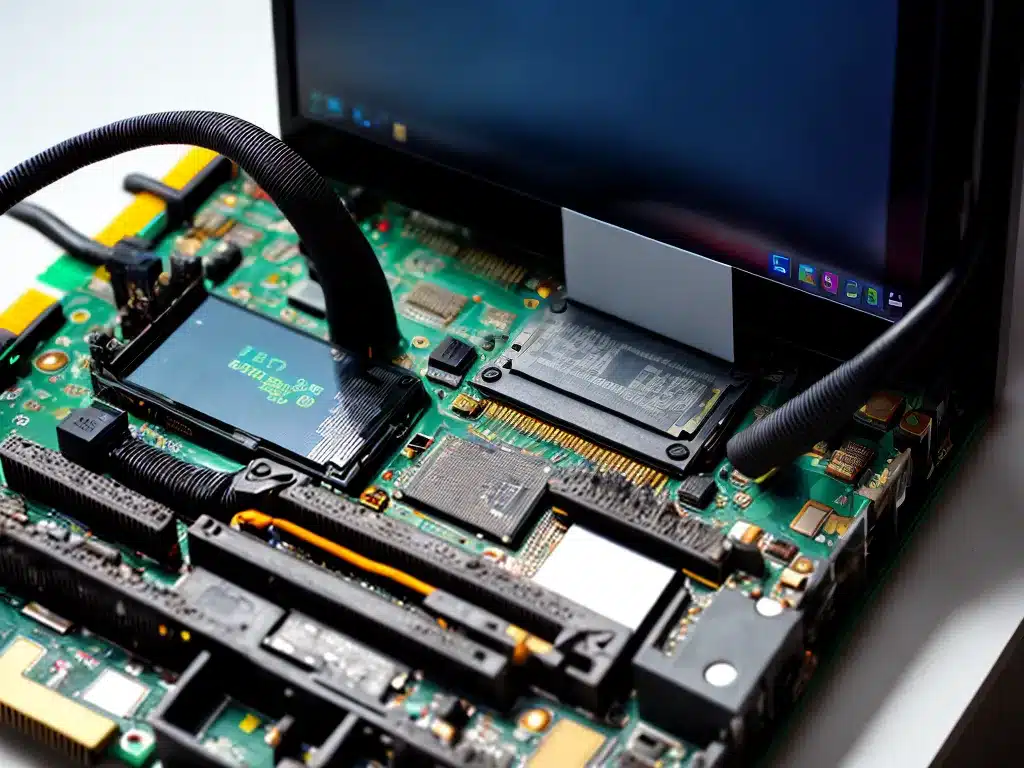
Fixing No Display Or Boot Issues
Troubleshooting and fixing no display or boot issues with your computer can be frustrating, but is doable with some persistence and know-how. Here are some tips I’ve learned over the years for diagnosing and repairing these problems:
Basic Troubleshooting Steps
Verify the Power Supply
The first thing to check is that the power supply is working correctly. Here’s how to confirm the power supply is operating:
- Check that the power cable is plugged into the wall outlet securely and the power supply brick. Make sure the wall outlet is switched on if it has a switch.
- Inspect the power cable and power brick for any damage or frayed/exposed wires. A damaged cable can cause power issues.
- For desktop PCs, open the case and check that the power supply cables are correctly and securely plugged into the motherboard and components. Reseat connections if needed.
- For laptops, try a different power outlet in case there is no power from a faulty outlet.
If the power supply passes these checks, it is likely working.
Check Connections and Reseat Components
Loose cables and connections can interrupt power and signal flow. Here’s how to check them:
- Examine all data and power cables for secure connections. Push cables firmly into ports to reseat them.
- For desktops, open the case and check component connections like RAM, graphics cards, storage drives. Remove and reinsert components to reseat them.
- For laptops, simply remove any external devices/cables and boot it alone to isolate the issue.
Faulty cables and connections are easy fixes for no display/boot issues.
Test with Minimum Configuration
Simplify the hardware configuration to narrow down what’s not working:
- For desktops, remove extra RAM, PCI cards, drives except the boot drive. Boot with only essentials.
- For laptops, boot with only the battery, AC power, internal display and keyboard connected.
If the minimum configuration boots properly, add back one component at a time until the failure recurs. This indicates the faulty component.
Advanced Troubleshooting and Repairs
If basic steps don’t resolve no display/boot, more investigation and repairs may be needed:
Test the Motherboard and CPU
The motherboard and CPU are central to the boot process:
- Listen for any beep codes from the motherboard speaker indicating a faulty component. Refer to the motherboard manual to decipher codes.
- Try booting with just the CPU, one RAM stick, onboard video if available to test the motherboard.
- Attempt booting with a different compatible CPU if available to isolate CPU faults.
Faulty motherboard/CPU can prevent successful booting.
Diagnose the Video Card
Issues with the graphics card can lead to blank display:
- Check the card’s power connections, display output ports for damage, any debug LED indicators on the card
-
Try the card in a different PCIe slot on the motherboard
-
Attempt booting integrated graphics if CPU/motherboard supports it
-
Test the card in a different PC if possible to verify
Video card failures commonly manifest as no video display.
Test and Replace the RAM
Defective RAM modules can stop boot process:
- Try booting with one stick at a time in different slots to isolate bad stick
- Inspect sticks for dirt on contacts, physical damage
-
Test sticks with diagnostic tools like MemTest86+
-
Replace the faulty RAM stick
RAM issues are a frequent source of failure to boot.
Repair Storage Drive Failures
Boot drives that fail to initialize properly will halt booting:
-
Check SATA/power connections for secure fit
-
Attempt booting from a USB drive or different boot drive
-
Diagnose drive with manufacturer tools for read/write failures
-
Repair or replace the storage drive if damaged
Corrupted or malfunctioning boot drives can prevent loading the OS.
Reflash the BIOS
A corrupted BIOS can stop the boot process entirely:
- Check the motherboard manual for BIOS reset jumper or button
- Use crisis recovery tools to restore a working BIOS
- As a last resort, reflash the BIOS chip with a programmer
BIOS issues are fixable, but can fully block booting.
With systematic troubleshooting and testing of components, the underlying hardware issue preventing display and booting can be uncovered and fixed. Don’t give up!
Preventing Recurrence of Display and Boot Problems
Once repaired, take steps to prevent future no display/boot issues:
-
Maintain stable power delivery – use surge protectors, UPS battery backup.
-
Keep the PC dust-free and well-ventilated to prevent overheating.
-
Update BIOS, drivers, OS regularly for optimal stability.
-
Handle components carefully to avoid physical damage of ports, chips, circuitry.
-
Back up critical data regularly in case boot drive fails again.
With good device care and maintenance habits, display and boot related problems can be minimized. But they may still occur infrequently as hardware ages. This guide will help get your PC running again!












